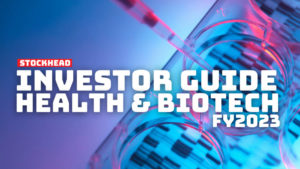Do you know where your frozen semen or egg samples really are being stored – and is it under optimal conditions?
Bluechiip (ASX:BCT) chief Andrew McLellan says biobanking customers would be shocked to see the rudimentary identification and tracking methods used for deep-frozen bodily samples – namely wonky bar codes and handwriting that would put a doctor to shame.
Or in the case of clinical trials, drug makers are spending squillions in the lab but they don’t have traceability or control of the key samples underpinning their efforts.
The developer of a wifi-enabled, durable tagging system for bio-specimens, the Melbourne based Bluechiip is on a quest to help the $US1 billion ($1.4 billion) a year sector lift its game.
Bluechiip claims to be only company that can provide identification and temperature tracking for every sample, whether it’s stored or transported.
The company has 33 granted patents in territories including the US, Europe and – of course – Australia.
“The tech is unique and it’s completely owned by Bluechiip,” Mr McLellan says.
Thiis iis Bluechiip
Bluechiip was founded in 2003 and listed on the ASX in 2011.
And from the outset we stress the spelling is correct: the extra ‘i’ was inserted to overcome trademark issues.
Over the two decades, Bluechiip has changed tack a few times in a commercial sense, but the underlying know-how has stayed the same.
The core technology was invented by former Royal Melbourne Institute of Technology academic Dr Ronald Zmood, a world leader in magnetic bearings, micro electro mechanical systems (MEMS) and control systems.
Bluechiip was co-founded by Dr Zmood and son-in-law Brett Schwarz, the company’s chief executive officer from listing to January 2014.
The Bluechiip device is a sensor embedded into bags or vials, recording the details (and temperature) of the specimens. The data is wirelessly conveyed to a reader (which looks like a TV remote) and is stored and displayed with associated software.
Currently four million Bluechiip chips are in use and the company’s European manufacturing facility has the capacity to churn out five million of them a year.
The company currently has 11 customers accounting for 13 labs, mainly in the US and Europe, but including four in Australia. Clients include Australian Regenerative Medicine Institute at Melbourne’s Monash University, Organa Bio, Crux Biolabs and long-time patron, the Paris-based Labcon.
Bluechiip has distribution networks in Europe and Asia, but is building direct “feet on the street” in North America.
The former head of the Advanced Manufacturing Cooperation Research Centre, McLellan has been Bluechiip’s CEO since January 2015.
“I’m hugely passionate about globalising Australian technologies,” he says.
Changing tack
In December 2021, Bluechiip launched its own range of consumables – primarily vials and blood bags – after winning approval from the US Food and Drug Administration (FDA), as well as European assent.
McLellan describes the development as “extremely important” for Bluechiip, as it enables the company to fly its own flag.
“We are now able to sell our own products into the end-marketplace and we are doing that,” he says. “It means we take control of our own destiny.”
Having said that, the company has also signed a compact with medical device giant Fujifilm/Irvine Scientific, covering the in-vitro fertilisation (IVF) market.
It’s expected the licensing and development agreement will move to a white-label arrangement, by which Bluechiip provides its sensors for Fujifilm/Irvine’s consumables.
Tech talk
Bluechiip’s sensors consist of a miniature chip with 52 mechanical beams, of varying lengths.
Each is turned on or off at the point of manufacture, to create a unique identification with billions of combinations. Samples can be tracked individually, or as large groups.
A bit like a tuning fork, the metallic beams resonate with specific frequencies.
The company describes the system, based on MEMS technology, as a “generational change” on written labels; and an improvement on barcodes and radio frequency identification (RFID) tracking.
The chips can withstand temperatures to minus 196 degrees Celsius, the boiling point of nitrogen. This makes them ideal for cryogenically stored bio-specimens such as stem cells, cord blood and Walt Disney.
With no electronic parts of wires, the sensors can also survive auto-claving, gamma radiation, sterilisation, humidification and centrifuging.
“About 25 per cent of bio-banks are still using handwriting in some form,” McLellan says.
“At such low temperatures the frost has to be wiped off the labels and RFID just doesn’t work at such extremes.”
Bluechiip readers don’t require line of sight to the item to receive accurate data.
$US1 billion target market
Bluechiip assesses its addressable market as well over $US1 billion in direct revenue alone, with North America accounting for 40 per cent.
The key target markets are IVF and assisted reproductive technologies, clinical trials, cell therapies, bio-banking and vaccine development.
With well over 300 million samples stored at minus 196 degrees, McLellan describes the opportunity as “significant”.
“In the case of clinical trials, even with just cell therapies, there are more than 1,000 trials going on, most of them in North America.”
A Bluechiip tube typically costs $US3.00 to $US4.00 apiece, compared with $US1.50 to $US2.00 for a standard item.
McLellan cites the set-up cost to a client as between $US30,000 to $US50,000, for the software and the readers (customers might also opt for a box reader that can scan hundreds of samples at once).
Typically, a customer would do thousands of samples a month, but a big one might do 15 million samples.
McLellan says two to three years ago customers were wary about the cost of adopting Bluechiip’s tracking.
“Now that we are selling the solution and not just the consumables, we don’t get any pushback at all,” he says.
He notes Bluechiip can eliminate “dual witnessing”: the need for two people to confirm a sample’s identification.
He adds that in the heavily regulated market the company targets, Bluechiip’s systems increasingly are being built into standard operating procedures.
Beyond human bio samples
While Bluechiip specialises in those really cold conditions – no, not Melbourne this unseasonal summer – other opportunities beckon in the cold-chain logistics sector.
This refers to food, drink and other consumer goods, typically stored at a balmy minus 20 degrees. One challenge in this sector is knowing whether an item such as a bag of peas has been stored at above optimal temperature for any length of time.
“We are currently focused on on-premises storage, but we think we can work across the whole cold chain,” McLellan says.
“While there’s a massive market in life science, we are also seeing opportunities in crop science (seed banks), veterinary, industrial and defence.”
Finances and performance
In the December 2022 quarter, Bluechiip chalked up record customer sales of $280,000, with money through the door (receipts) of $527,000.
But after recording outflows of $988,000, Bluechiip’s cash position was tighter than a Tupperware seal. The end-of-December cash balance was $575,000, enough to fund just over a quarter of expenditure when a $57,000 unused facility is included.
On those numbers, Bluechiip should be in the corporate deep freeze by now.
But McLellan says the picture is not so dire, given the expected receivables and a $825,000 Federal Research and Development Tax Incentive received after the December balance date.
In December, the company also received the first $173,000 of an $825,000 grant from the Federal Government’s Supply Chain Resilience Initiative (included in the ‘receipts’ total). We hadn’t heard of that one either, but suffice to say the company was one of only 18 successful applicants.
McLellan says the company expects revenue to increase this quarter, given it signed up a “very large” customer in the December quarter. This client is expected to use Bluechiip in only one laboratory initially, expanding to between five and eight.
“Our pipeline continues to grow and we expect the number of accounts in our pipeline and conversions to accelerate in the current and future quarters,” he says.
Bluechiip expects a further $1 million Federal Research and Development Tax Incentive payment this current year. If it needs to, the company can access a financing arrangement allowing for an advance on this payment.
On the cost side, outflows are expected to remain at around $1 million per quarter, as the company builds its sales capacity.
In the mid-term, the company expects to invest in automation.
Bluechiip shares have ranged between two cents in September 2016 to 27 cents in July 2012. At the current 2.7 cents per share, Bluechiip is valued at a mere $16 million, with the shares losing one-third of their value over the last 12 months.
Bluechiip stock share price today
Covid radio silence
For the two years of the pandemic, management couldn’t travel overseas to talk to clients and partners face-to-face.
“Big Pharma checked out the product in 2019, but then there was radio silence until the start of 2022,” McLellan says.
“While there are a lot of samples going around, most of them were for Covid.”
But the company seized the chance to expedite product development and nail the boring-but-important stuff, such as International Standards Organisation certification.
McLellan says an upside to the pandemic was the populace’s heightened appreciation of medical science: “Two years ago, you would never have seen a liquid nitrogen tank on a TV news article and then we went through a period where we saw it every night.”
Dr Boreham’s diagnosis:
When we last covered Bluechiip in October 2017 – and it’s been a long time between frozen slushies – we opined that the company looked to be on the cusp of serious revenues and great fame and fortune after a protracted development period.
As is almost inevitably the case with biotechs, reaching this point of transition has proved elusive. But dare we say, Bluechiip now looks to be on the cusp of serious revenues and great fame and fortune after a protracted development period.
McLellan says customers long have been frustrated by the travails of deep-freeze identification, but with the absence of any product in the market there hasn’t been much clamoring for a solution.
“We’re going in there and communicating that we are available.”
McLellan says biotechnology is a “follow-the-leader market, in that if you get the early adopters, the rest of the world will follow”.
Not surprisingly, Bluechiip intends to be the leader and – for the time being at least – the company looks to have the market to itself. Given there are thousands of labs handling more than 300 million samples a year “we are only scratching the surface.”
But this enviable monopoly status will amount to nought if Bluechiip doesn’t have enough funds to keep the lights on and the freezers running.
Disclosure: Dr Boreham is not a qualified medical practitioner and does not possess a doctorate of any sort. He was thought to be on the cusp of great fame and fortune, but this has proved elusive.
The views, information, or opinions expressed in the interviews in this article are solely those of the interviewees and do not represent the views of Stockhead. Stockhead does not provide, endorse or otherwise assume responsibility for any financial product advice contained in this article.
This column first appeared in Biotech Daily
You might be interested in












